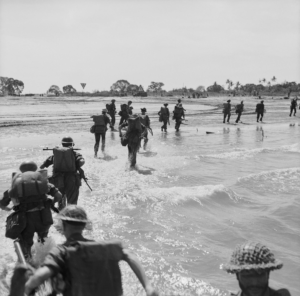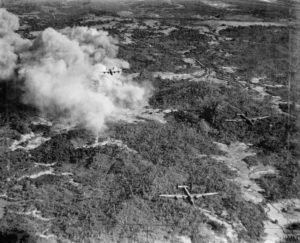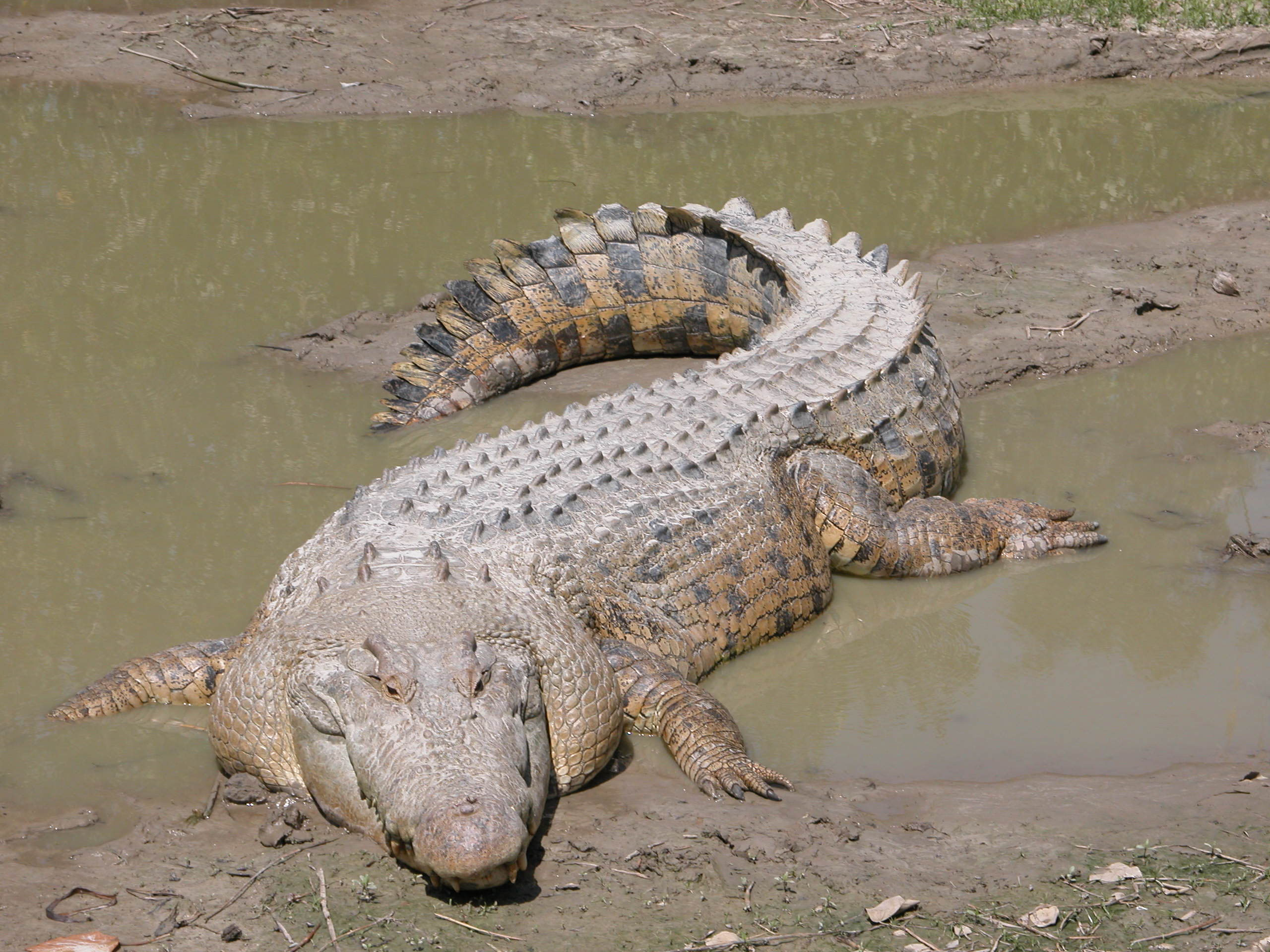Soldiers fighting on Ramree Island in 1945 faced a more treacherous foe than any human enemy—the saltwater crocodile. A strategic battle for control of the isle, located just north of Rangoon, Burma, resulted in crocodile attacks on Japanese troops in a mangrove swamp.
The exact number of men killed by crocodiles remains a mystery. British survivors of the battle estimated that about 1,000 Japanese were attacked by the giant reptiles—a claim which gave rise to sensational stories and has been disputed by historian Frank McLynn.
Despite the numerical debates, the fact remains that Japanese combatants were killed by crocodiles while resisting British troops.
Crocodiles were an environmental hazard in many battlegrounds across Southeast Asia and the Pacific. British soldiers in India and Burma took measures to protect themselves from ambushes by freshwater crocodiles during maneuvers across inland canals and waterways.
“When we swam in … small tributaries … a soldier or one of your group stood by with a rifle with .303 ammunition in case of attack by a small type of crocodile called a mugger,” jungle warfare veteran Lt. Col. William Albert Weightman told the Imperial War Museum in a 1990 interview about his time in the 1943-1945 Burma campaign.
“The jungle can be your friend and it can be your worst enemy, depending on time, place, circumstances,” Weightman said.

Ramree Island, a small muddy landmass on the Burma coast, caught the eye of British military forces that wished to create a supply point for troops operating on the mainland. The uncultivated island had no harbor; British soldiers were dropped on the beaches by landing craft. Their task was to capture the island from occupying Japanese troops in order to build an airfield.
“The navy said they didn’t know how we would get off the island, so it was a case of get rid of the [Japanese] or be taken prisoner,” recalled artilleryman Robert Duff, who fought on Ramree Island and witnessed the events surrounding the mass crocodile attack.
Trained as a commando, Duff was no stranger to fighting the Japanese in dense jungles. Before the fight on Ramree, he had experienced horrifying conditions in Burma in 1944. Soldiers lived in a miasma of fever amid bodies decomposing in the heat. Invisible Japanese assailants stalked from the trees and shadows.
“It was like hide and seek. We never knew where the [Japanese] were, and because we couldn’t make a sound we communicated with sign language. Night time was the worst, on guard duty—two hours on, four hours off—trying to stay awake and thinking that any second you’d get a bayonet in the back,” Duff recalled in a 2006 BBC oral history.
Once a sniper’s bullet missed Duff by a few inches during an unguarded moment, hitting his map case. On another occasion, volunteers were needed for a mission behind Japanese lines—nobody was willing to go, so the men cut a deck of cards to choose the unlucky. Duff picked a losing hand and advanced into the jungle, thinking of his doom.
“We were now completely cut off from our own troops, and I thought ‘that’s the last I’ll see of them, or home,’” he recalled. Yet he beat the odds. After bouts of hospitalization from amoebic dysentery, ulcers and malaria, Duff survived to go to Ramree the following January.
According to a 1945 dispatch by Vice Admiral Arthur Power, commander in chief of the Royal Navy’s East Indies Fleet, the Japanese initially put up fierce resistance at Ramree but were caught off guard by a complex British assault.
“The Japanese had developed a strong defensive position guarding the beaches…. Their main body was established near Ramree Town. A landing at Kyaukpyu was unexpected and tactical surprise was achieved,” Power reported to the Lords Commissioner of the Admiralty.
Following “brisk fighting,” Ramree Town fell to the British on February 8, leaving the Japanese “only two alternatives: to stand and fight or to escape from the island by water,” according to Power. “They chose the latter alternative, and in so doing met with disaster.”

To prevent Japanese troops from escaping the island via boat, the British launched Operation Block—a combined operation in which Royal Navy destroyers blocked water exits, the RAF strafed Japanese boats and ground forces encircled Japanese units on the ground. The operation lasted from February 8 to 22.
“We had some very hard fighting,” remembered Duff, who took part in the operation, “but after a few weeks we managed to push the [Japanese] to the swamp on the other side of the island, which was full of crocodiles.”
The swamp that Duff recalled was a mangrove forest. Such swamps are natural habitats for saltwater crocodiles, which thrive in coastal environments and use ocean currents to travel. “Salties” are unique in their ability to survive for long periods without food, and opportunistically prey on creatures that stray into their environment. The crocodiles will eat prey dead or alive, swallowing victims whole whenever possible. They can grow up to 20 feet long and have been known to attack large animals, including bulls. The saltwater crocodile is alleged to have the strongest bite pressure of any living animal. According to the Australian Reptile Park in Sydney, an adult saltwater crocodile “will eat almost anything that comes too close.”
A feeding frenzy is said to have occurred when defeated Japanese soldiers—refusing to surrender—decided to make their last stand among the mangroves.
“Disadvantages to the Japanese lay in the indescribable horrors of the mangrove swamps,” Power wrote in his report. “Dark during the day as well as during the night, acres of thick impenetrable forest; miles of deep black mud, mosquitos, scorpions, flies and weird insects by the billion and—worst of all—crocodiles.”
British soldiers on boats near the swamp called out to the Japanese to surrender using loudspeakers to no avail.
“They decided to take their chances in the swamp rather than surrender,” Duff recalled. “Only a handful came out alive.”
Crocodiles, nocturnal predators, struck at nighttime shortly after the Japanese entered the mangrove swamp. Eyewitness Bruce Stanley Wright recalled in his 1962 book, “Wildlife Sketches Near and Far,” that the crocodiles began gathering among the mangrove trees during the battle and moved in as the tide ebbed, targeting Japanese soldiers stuck in the mud or trapped near the water’s edge.
“That night [Feb. 19, 1945] was the most horrible that any member of the M.L. [marine launch] crews ever experienced,” Wright wrote, recalling the secondhand trauma of British soldiers overhearing the crocodile attacks. “The scattered rifle shots in the pitch black swamp punctured by the screams of the wounded men crushed in the jaws of huge reptiles, and the blurred worrying sound of spinning crocodiles made a cacophony of hell that has rarely been duplicated on Earth. At dawn the vultures arrived to clean up what the crocodiles had left.”
Only a few days after entering the mangrove swamp, the surviving Japanese surrendered. Aside from the crocodiles, lack of food and drinking water made it impossible for the soldiers to survive.
“It proved to be beyond even their endurance to exist for more than a few days,” Power wrote. “Prisoners taken out of the mangroves during the operations were found to be semi-dehydrated and in a very low physical condition.”
There were an an estimated 1,200 to 1,500 Japanese soldiers on Ramree Island when British forces had landed. When the battle was over, only 20 Japanese survived and were taken prisoner, despite “all efforts of persuasion towards the close of Operation Block” to get them to surrender, Power wrote.
Power estimated that the remainder were killed in battle or perished in the mangrove swamp.
How many men fell to an unseen crocodile army remains a mystery.
After surviving the ordeals of Ramree, Duff was given a month’s leave in summer 1945 and participated in a parade in August. After months in Burma, he had gotten used to wearing “rags,” to the point that wearing a regular uniform felt like “rough blankets,” he remembered. He found participating in a parade after the horrors of jungle combat to be a surreal experience.
“When we came back to camp we had to parade the next day; this was the last time with all the guns. We stood in a field in two columns and the guns were driven past in a long line. It seemed unusually quiet,” he remembered. “When my gun went past I went very cold. I suddenly realized how lucky I was to still be alive. None of us spoke, we just stood there, probably all thinking the same thoughts.”
—





